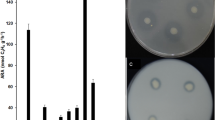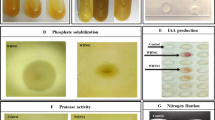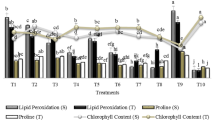Abstract
The salinity and sodicity of soils lead to the inhibition of the plant’s growth and disequilibrium of the nutrients, and thus reduce their plant uptake in the soil. The aims of this study were to characterize the indigenous plant growth-promoting rhizobacteria (PGPR) of wheat rhizosphere and to evaluate their ability with sulfur to improve nutrient uptake and wheat yield in saline-sodic soils. To do so, the bacteria were isolated from wheat rhizosphere cultivated in saline-sodic soils and screened for plant growth-promoting (PGP) traits. The superior PGPR was identified by 16S rRNA gene sequencing. A greenhouse experiment was carried out in a completely randomized factorial design with different levels of salinity and sodicity, bacteria inoculation, and levels of sulfur along with Thiobacillus thiooxidans. Results showed that Pseudomonas alcaliphila, Bacillus subtilis, and Rhizobium pusense were the superior PGPR in the wheat rhizosphere. Grain yield and nutrient concentrations of wheat grain decreased with increasing soil salinity and sodicity. Bacteria inoculation, especially R. pusense showed a marked exopolysaccharide and ACC-deaminase production increased grain yield, N and P concentrations and Ca/Mg ratio at different levels of soil sodicity and salinity. R. pusence and B. subtilis facilitated higher concentrations of N and P in wheat when used concurrently with sulfur and T. thiooxidans, respectively. Overall, the results indicated that the application of isolated PGPR of wheat rhizosphere possessed PGP traits especially R. pusense along with sulfur and T. thiooxidans, resulted in excellent benefits on wheat growth in saline-sodic soils.



Similar content being viewed by others
REFERENCES
P. Abbas-Zadeh, N. Saleh-Rastin, H. Asadi-Rahmani, K. Khavazi, A. Soltani, A. Shoary-Nejati, and M. Miransari, “Plant growth-promoting activities of fluorescent pseudomonads, isolated from the Iranian soils,” Acta Physiol. Plant. 32, 281–288 (2010).
R. Abbas, S. Rasul, K. Aslam, M. Baber, M. Shahid, F. Mubeen, and T. Naqqash, “Halotolerant PGPR: a hope for cultivation of saline soils,” J. King Saud Univ., Sci. 31, 1195–1201 (2019).
M. Abbasi, S. Sharif, M. Kazmi, T. Sultan, and M. Aslam, “Isolation of plant growth promoting rhizobacteria from wheat rhizosphere and their effect on improving growth, yield and nutrient uptake of plants,” Plant Biosyst. 145, 159–168 (2011).
K. Ahmed, G. Qadir, A. R. Jami, A. I. Saqib, M. Nawaz, M. Kamal, and E. Haq, “Comparative reclamation efficiency of gypsum and sulfur for improvement of salt affected,” Bulg. J. Agric. Sci. 23, 126–133 (2017).
A. A. Al-Enazy, F. Al-Barakah, S. Al-Oud, and A. Usman, “Effect of phosphogypsum application and bacteria co-inoculation on biochemical properties and nutrient availability to maize plants in a saline soil,” Arch. Agron. Soil Sci. 64, 1394–1406 (2018).
D. Alexander and D. Zuberer, “Use of chrome azurol S reagents to evaluate siderophore production by rhizosphere bacteria,” Biol. Fertil. Soils 12, 39–45 (1991).
S. Z. Ali, V. Sandhya, and L. Venkateswar Rao, “Isolation and characterization of drought-tolerant ACC deaminase and exopolysaccharide-producing fluorescent Pseudomonas sp.,” Ann. Biol. Res. 64, 493–502 (2014).
Z. T. Alipour and A. Sobhanipour, “The effect of Thiobacillus and Pseudomonas fluorescent inoculation on maize growth and Fe uptake,” Ann. Biol. Res. 3, 1661–1666 (2012).
M. M. Aria, A. Lakzian, G. H. Haghnia, A. R. Berenji, H. Besharati, and A. Fotovat, “Effect of Thiobacillus, sulfur, and vermicompost on the water-soluble phosphorus of hard rock phosphate,” Bioresour. Technol. 101, 551–554 (2010).
H. Asadi Rahmani, K. Khavazi, V. A. Jahandideh Mahjen Abadi, M. Ramezanpour, M. Mirzapour, and K. Mirzashahi, “Effect of Thiobacillus, sulfur, and phosphorus on the yield and nutrient uptake of canola and the chemical properties of calcareous soils in Iran,” Commun. Soil Sci. Plant Anal. 49, 1671–1683 (2018).
A.B. Bleecker and H. Kende, “Ethylene: a gaseous signal molecule in plants,” Annu. Rev. Cell Dev. Biol. 16, 1–18 (2000).
T. Chaudhary, R. Gera, and P. Shukla, “Deciphering the potential of Rhizobium pusense MB-17a, a plant growth-promoting root endophyte, and functional annotation of the genes involved in the metabolic pathway,” Front. Bioeng. Biotechnol. 8, 617034 (2021).
T. Damodaran, V. Mishra, S. Jha, U. Pankaj, G. Gupta, and R. Gopal, “Identification of rhizosphere bacterial diversity with promising salt tolerance, PGP traits and their exploitation for seed germination enhancement in sodic soil,” Agric. Res. 8, 36–43 (2019).
T. Damodaran, D. Sharma, V. Mishra, S. Jha, R. Kannan, V. Sah, and R. Rai, “Isolation of salt tolerant endophytic and rhizospheric bacteria by natural selection and screening for promising plant growth-promoting rhizobacteria (PGPR) and growth vigour in tomato under sodic environment,” Afr. J. Microbiol. Res. 7, 5082–5089 (2013).
S. Day, J. Norton, C. Strom, T. Kelleners, and E. Aboukila, “Gypsum, langbeinite, sulfur, and compost for reclamation of drastically disturbed calcareous saline–sodic soils,” Int. J. Environ. Sci. Technol. 16, 295–304 (2019).
E. Dell’Amico, L. Cavalca, and V. Andreoni, “Analysis of rhizobacterial communities in perennial Graminaceae from polluted water meadow soil, and screening of metal-resistant, potentially plant growth-promoting bacteria,” FEMS Microbiol. Ecol. 52, 153–162 (2005).
M. Dworkin and J. Foster, “Experiments with some microorganisms which utilize ethane and hydrogen,” J. Bacteriol. 75, 592–603 (1958).
A. M. El-Sawah, A. El-Keblawy, D. F. I. Ali, H. M. Ibrahim, M. A. El-Sheikh, A. Sharma, Y. Alhaj Hamoud, H. Shaghaleh, M. Brestic, and M. Skalicky, “Arbuscular mycorrhizal fungi and plant growth-promoting rhizobacteria enhance soil key enzymes, plant growth, seed yield, and qualitative attributes of guar,” Agriculture 11, 194 (2021).
A. Elgharably and N. A. Nafady, “Inoculation with Arbuscular mycorrhizae, Penicillium funiculosum and Fusarium oxysporum enhanced wheat growth and nutrient uptake in the saline soil,” Rhizosphere 18, 100345 (2021).
H. Evelin, T. S. Devi, S. Gupta, and R. Kapoor, “Mitigation of salinity stress in plants by arbuscular mycorrhizal symbiosis: current understanding and new challenges,” Front. Plant Sci. 10, 470 (2019).
C. M. Ferreira, Â. Vilas-Boas, C. A. Sousa, H. M. Soares, and E. V. Soares, “Comparison of five bacterial strains producing siderophores with ability to chelate iron under alkaline conditions,” AMB Express 9, 1–12 (2019).
R. Flores-Vargas and G. O’hara, “Isolation and characterization of rhizosphere bacteria with potential for biological control of weeds in vineyards,” J. Appl. Microbiol. 100, 946–954 (2006).
R. Fusconi and M. Godinho, “Screening for exopolysaccharide-producing bacteria from sub-tropical polluted groundwater,” Braz. J. Biol. 62, 363–369 (2002).
K. E. Gerhardt, G. J. MacNeill, P. D. Gerwing, and B. M. Greenberg, “Phytoremediation of salt-impacted soils and use of plant growth-promoting rhizobacteria (PGPR) to enhance phytoremediation,” in Phytoremediation, Ed. by A. A. Ansari (Springer International Publishing, 2017), pp. 19–51.
B. R. Glick, “Bacteria with ACC deaminase can promote plant growth and help to feed the world,” Microbiol. Res. 169, 30–39 (2014).
S. A. Gordon and R. P. Weber, “Colorimetric estimation of indoleacetic acid,” Plant Physiol. 26, 192 (1951).
Y. W. Gui, M. S. Sheteiwy, S. G. Zhu, A. Batool, and Y. C. Xiong, “Differentiate effects of non-hydraulic and hydraulic root signaling on yield and water use efficiency in diploid and tetraploid wheat under drought stress,” Environ. Exp. Bot. 181, 104287 (2021).
S. Hajinia, M. J. Zarea, F. Rejali, and A. Varma, “Yield and yield components of wheat as affected by salinity and inoculation with Azospirillum strains from saline or non-saline soil,” J. Saudi Soc. Agric. Sci. 11, 113–121 (2012).
M. Huber, W. V. Bienvenut, E. Linster, I. Stephan, L. Armbruster, C. Sticht, D. Layer, K. Lapouge, T. Meinnel, and I. Sinning, “NatB-mediated N-terminal acetylation affects growth and biotic stress responses,” Plant Physiol. 182, 792–806 (2020).
H. M. Ibrahim and A. M. El-Sawah, “The mode of integration between azotobacter and rhizobium affect plant growth, yield, and physiological responses of pea (Pisum sativum L.),” J. Soil Sci. Plant Nutr. 22, 1238–1251 (2022).
N. O. Igiehon, O. O. Babalola, and B. R. Aremu, “Genomic insights into plant growth promoting rhizobia capable of enhancing soybean germination under drought stress,” BMC Microbiol. 19, 1–22 (2019).
V. A. Jahandideh Mahjenabadi and M. Sepehri, “Effect of Piriformospora indica and Azotobacter chroococcum on mitigation of zinc deficiency stress in wheat (Triticum aestivum L.),” Symbiosis 69, 9–19 (2016).
V. A. Jahandideh Mahjenabadi, M. Sepehri, B. Khatabi, and M. Rezaei, “Alleviation of zinc deficiency in wheat inoculated with root endophytic fungus Piriformospora indica and rhizobacterium Pseudomonas putida,” Rhizosphere 17, 100311 (2021).
V. A. Jahandideh Mahjenabadi, M. Sepehri, H. A. Rahmani, M. Zarei, A. Ronaghi, S. M. Taghavi, and M. Shamshiripour, “Role of dominant phyllosphere bacteria with plant growth–promoting characteristics on growth and nutrition of maize (Zea mays L.),” J. Soil Sci. Plant Nutr. 20, 2348–2363 (2020).
A. Jamil, S. Riaz, M. Ashraf, and M. Foolad, “Gene expression profiling of plants under salt stress,” Crit. Rev. Plant Sci. 30, 435–458 (2011).
H. Jiang, H. Dong, G. Zhang, B. Yu, L. R. Chapman, and M. W. Fields, “Microbial diversity in water and sediment of Lake Chaka, an athalassohaline lake in northwestern China,” Appl. Environ. Microbiol. 72, 3832–3845 (2006).
A. Karnwal, “Screening, isolation and characterization of culturable stress-tolerant bacterial endophytes associated with Salicornia brachiata and their effect on wheat (Triticum aestivum L.) and maize (Zea mays) growth,” J. Plant Prot. Res. 59, 293–303 (2019).
M. Keisham, S. Mukherjee, and S. C. Bhatla, “Mechanisms of sodium transport in plants—progresses and challenges,” Int. J. Mol. Sci. 19, 647 (2018).
K. Khavazi, V. A. Jahandideh Mahjanabadi, and F. Taghipoor, “Effect of sulfur, Thiobacillus bacteria and phosphorus on the yield and nutrient elements uptake of wheat in calcareous soil,” J. Soil Manage. Sustainable Prod. 8, 23–41 (2018).
P. M. Kopittke, N. W. Menzies, P. Wang, B. A. McKenna, and E. Lombi, “Soil and the intensification of agriculture for global food security,” Environ. Int. 132, 105078 (2019).
A. Kumar, S. Singh, A. K. Gaurav, S. Srivastava, and J. P. Verma, “Plant growth-promoting bacteria: biological tools for the mitigation of salinity stress in plants,” Front. Microbiol. 11, 1216 (2020).
R. Leogrande and C. Vitti, “Use of organic amendments to reclaim saline and sodic soils: a review,” Arid Land Res. Manage. 33, 1–21 (2019).
H. Li and X. Jiang, “Inoculation with plant growth-promoting bacteria (PGPB) improves salt tolerance of maize seedling,” Russ. J. Plant Physiol. 64, 235–241 (2017).
A. K. Manesh, M. Armin, and M. J. Moeini, “The effect of sulfur application on yield and yield components of corn in two different planting methods in saline conditions,” Int. J. Agron. Plant Prod. 4, 1474–1478 (2013).
A. Maxton, P. Singh, and S. A. Masih, “ACC deaminase-producing bacteria mediated drought and salt tolerance in Capsicum annuum,” J. Plant Nutr. 41, 574–583 (2018).
U. Mc Carthy, I. Uysal, R. Badia-Melis, S. Mercier, C. O’Donnell, and A. Ktenioudaki, “Global food security–issues, challenges and technological solutions,” Trends Food Sci. Technol. 77, 11–20 (2018).
M. I. Mir, B. K. Kumar, S. Gopalakrishnan, S. Vadlamudi, and B. Hameeda, “Characterization of rhizobia isolated from leguminous plants and their impact on the growth of ICCV 2 variety of chickpea (Cicer arietinum L.),” Heliyon 7, e08321 (2021).
S. Misra, V. K. Dixit, M. H. Khan, S. K. Mishra, G. Dviwedi, S. Yadav, A. Lehri, and P. S. Chauhan, “Exploitation of agro-climatic environment for selection of 1-aminocyclopropane-1-carboxylic acid (ACC) deaminase producing salt tolerant indigenous plant growth promoting rhizobacteria,” Microbiol. Res. 205, 25–34 (2017).
V. Nair, D. Graetz, and K. Portier, “Forms of phosphorus in soil profiles from dairies of South Florida,” Soil Sci. Soc. Am. J. 59, 1244–1249 (1995).
G. Najar, S. Singh, F. Akhtar, and S. Hakeem, “Influence of sulphur level on yield, uptake and quality of soybean (Glycine max) under temperate conditions of Kashmir valley,” Indian J. Agric. Sci. 81, 340–343 (2011).
F. X. Nascimento, M. J. Rossi, and B. R. Glick, “Role of ACC deaminase in stress control of leguminous plants,” in Plant Growth Promoting Actinobacteria, Ed. by G. Subramaniam, S. Arumugam, and V. Rajendran (Springer Science, Singapore, 2016), pp. 179–192.
H. Naseem, M. Ahsan, M. A. Shahid, and N. Khan, “Exopolysaccharides producing rhizobacteria and their role in plant growth and drought tolerance,” J. Basic Microbiol. 58, 1009–1022 (2018).
A. Nazarov, L. Anan’ina, A. Gorbunov, and A. Pyankova, “Bacteria producing ectoine in the rhizosphere of plants growing on technogenic saline soil,” Eurasian Soil Sci. 55, 1074–1081 (2022).
K. T. Osman, “Saline and sodic soils,” in Management of Soil Problems, Ed. by K. T. Osman (Springer, Cham, 2028), pp. 255–298.
J. Pan, F. Peng, X. Xue, Q. You, W. Zhang, T. Wang, and C. Huang, “The growth promotion of two salt-tolerant plant groups with PGPR inoculation: a meta-analysis,” Sustainability 11, 378 (2019).
Z. Rahneshan, F. Nasibi, and A. A. Moghadam, “Effects of salinity stress on some growth, physiological, biochemical parameters and nutrients in two pistachio (Pistacia vera L.) rootstocks,” J. Plant Interact. 13, 73–82 (2018).
S. Rezvani Borujeni, K. Khavazi, A. Asgharzadeh, and I. Rezvani Borujeni, “Use of bacterial acc deaminase to increase oil (especially poly aromatic hydrocarbons) phytoremediation efficiency for maize (zea mays) seedlings,” Int. J. Phytorem. 20, 476–482 (2018).
D. Saghafi, M. Ghorbanpour, and B. A. Lajayer, “Efficiency of Rhizobium strains as plant growth promoting rhizobacteria on morpho-physiological properties of Brassica napus L. under salinity stress,” J. Soil Sci. Plant Nutr. 18, 253–268 (2018).
J. Sambrook and D. Russell, Molecular Cloning: a Laboratory Manual (Cold Spring Harbor, New York, 2001).
V. Sandhya and S. Z. Ali, “The production of exopolysaccharide by Pseudomonas putida GAP-P45 under various abiotic stress conditions and its role in soil aggregation,” Microbiology 84, 512–519 (2015).
B. Sashidhar and A. R. Podile, “Mineral phosphate solubilization by rhizosphere bacteria and scope for manipulation of the direct oxidation pathway involving glucose dehydrogenase,” J. Appl. Microbiol. 109, 1–12 (2010).
G. Selvakumar, P. Panneerselvam, and A. N. Ganeshamurthy, “Bacterial mediated alleviation of abiotic stress in crops,” in Bacteria in Agrobiology: Stress Management, Ed. by D. K. Maheshwari (Springer-Verlag, Berlin Heidelberg, 2012), pp. 205–224.
R. Shahriaripour, A. T. Pour, V. Mozaffari, H. Dashti, and E. Adhami, “Effects of salinity and soil zinc application on growth and chemical composition of pistachio seedlings,” J. Plant Nutr. 33, 1166–1179 (2010).
A. Sharma, K. Dev, A. Sourirajan, and M. Choudhary, “Isolation and characterization of salt-tolerant bacteria with plant growth-promoting activities from saline agricultural fields of Haryana, India,” Genet. Eng. Biotechnol. 19, 1–10 (2021).
M. S. Sheteiwy, H. Abd Elgawad, Y. C. Xiong, A. Macovei, M. Brestic, M. Skalicky, H. Shaghaleh, Y. Alhaj Hamoud, and A. M. El-Sawah, “Inoculation with Bacillus amyloliquefaciens and mycorrhiza confers tolerance to drought stress and improve seed yield and quality of soybean plant,” Physiol. Plant. 172, 2153–2169 (2021).
J. I. Sperber, “The incidence of apatite-solubilizing organisms in the rhizosphere and soil,” Aust. J. Agric. Res. 9, 778–781 (1958).
K. Tamura, J. Dudley, M. Nei, and S. Kumar, “M-EGA4: molecular evolutionary genetics analysis (MEGA) software version 4.0,” Mol. Boil. Evol. 24, 1596–1599 (2007).
S. Tewari and N. K. Arora, “Multifunctional exopolysaccharides from Pseudomonas aeruginosa PF23 involved in plant growth stimulation, biocontrol and stress amelioration in sunflower under saline conditions,” Curr. Microbiol. 69, 484–494 (2014).
S. Upadhyay, J. Singh, and D. Singh, “Exopolysaccharide-producing plant growth-promoting rhizobacteria under salinity condition,” Pedosphere 21, 214–222 (2011).
R. Vidyalakshmi, R. Paranthaman, and R. Bhakyaraj, “Sulphur oxidizing bacteria and pulse nutrition- a review,” World J. Agric. Sci. 5, 270–278 (009).
S. S. K. P. Vurukonda, S. Vardharajula, M. Shrivastava, and A. SkZ, “Enhancement of drought stress tolerance in crops by plant growth promoting rhizobacteria,” Microbiol. Res. 184, 13–24 (2016).
A. Wakeel, “Potassium–sodium interactions in soil and plant under saline-sodic conditions,” J. Plant Nutr. Soil Sci. 176, 344–354 (2013).
I. Walinga, W. V. Vark, V. J. Houba, and J. J. Van der Lee, Soil and Plant Analysis: a Series of Syllabi, Part 7: Plant Analysis Procedures (Wageningen Agriculture Univ., Wageningen, 1989).
M. Zafar-ul-Hye, H. M. Farooq, and M. Hussain, “Bacteria in combination with fertilizers promote root and shoot growth of maize in saline-sodic soil,” Braz. J. Microbiol. 46, 97–102 (2015).
M. Zafar-ul-Hye, A. Nasir, M. Aon, S. Hussain, M. Ahmad, and I. Naz, “Seed inoculation with Pseudomonas fluorescens and Pseudomonas syringae enhanced maize growth in a compacted saline-sodic soil,” Phyton 87, 25 (2018).
Y. Zheng, X. Li, Y. Li, B. Miao, H. Xu, M. Simmons, and X. Yang, “Contrasting responses of salinity-stressed salt-tolerant and intolerant winter wheat (Triticum aestivum L.) cultivars to ozone pollution,” Plant Physiol. Biochem. 52, 169–178 (2012).
Funding
This study was funded by the Soil and Water Research Institute (SWRI), Karaj, Iran.
Author information
Authors and Affiliations
Corresponding author
Ethics declarations
The authors declare that they have no conflicts of interest.
Rights and permissions
About this article
Cite this article
Javadzadeh, M., Khavazi, K., Ghanavati, N. et al. Utilizing the Indigenous Plant Growth-Promoting Rhizobacteria and Sulfur in Improving Yield and Nutrients Uptake of Wheat in Saline-Sodic Soils. Eurasian Soil Sc. 56, 1101–1113 (2023). https://doi.org/10.1134/S106422932360015X
Received:
Revised:
Accepted:
Published:
Issue Date:
DOI: https://doi.org/10.1134/S106422932360015X




